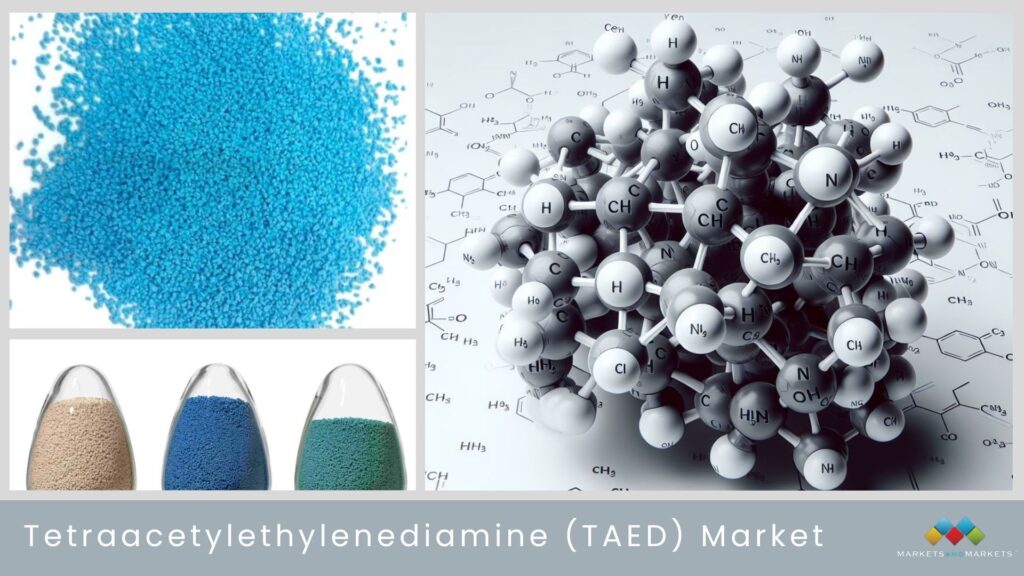
Tetraacetylethylenediamine (TAED) is not just another chemical compound—it’s a game-changer for industries striving to balance efficiency, cost-effectiveness, and sustainability. Whether you’re in the textile sector, the consumer goods cleaning care space, or the paper and pulp industry, TAED has likely impacted your processes in ways that are both profound and practical.
The Significance of TAED Across Industries
Tetraacetylethylenediamine (TAED) Market size is projected to grow from USD 881 million in 2024 to USD 1,070 million by 2029, registering a CAGR of 4.0% during the forecast period.
TAED, an organic compound widely used as an activator in oxygen-based bleaching agents, is valued for its ability to enable efficient bleaching at lower temperatures. When paired with hydrogen peroxide, it produces peracetic acid—a highly effective oxidizing agent. This unique chemical reaction has made TAED an essential ingredient across diverse industries:
- Textile Industry:
Bleaching textiles without compromising fabric integrity is a persistent challenge. TAED addresses this by allowing effective bleaching at reduced temperatures, helping textile manufacturers save energy while achieving brilliant whiteness and maintaining fabric strength. - Consumer Goods and Cleaning Care:
From dishwashing tablets to laundry detergents, TAED has become synonymous with effective, low-temperature cleaning. Consumers want spotless results without the environmental guilt, and TAED delivers by cutting down on energy consumption during the wash cycle. - Paper and Pulp Industry:
For the paper and pulp sector, transitioning away from chlorine-based bleaching processes is vital to meet stringent environmental regulations. TAED provides a greener alternative, ensuring high-quality, bright paper production without the associated ecological impact.
Key Drivers of TAED Market Growth
The growing relevance of TAED can be traced to several trends shaping today’s industrial landscape:
- Sustainability at the Forefront:
Companies worldwide are under immense pressure to adopt eco-friendly practices. TAED, being biodegradable and non-toxic, aligns perfectly with this shift, helping businesses meet regulatory requirements while reducing their environmental footprint. - Energy Efficiency Demands:
Rising energy costs have forced industries to rethink traditional high-temperature processes. TAED’s efficiency at lower temperatures doesn’t just cut costs—it also supports corporate sustainability goals. - Evolving Consumer Preferences:
In the cleaning and personal care sectors, modern consumers are demanding products that are not only effective but also environmentally conscious. TAED’s role in enabling low-energy, high-performance cleaning solutions meets this demand head-on.
Global Market Insights: Regional Dynamics
The TAED market is witnessing diverse growth patterns globally:
- Europe:
Europe’s stringent environmental regulations have made it a leader in TAED adoption. The region’s well-established textile and cleaning product industries have embraced TAED for its sustainable benefits. - Asia-Pacific:
Industrial expansion in countries like India and China has fueled demand for TAED. With growing urbanization and a rising middle class, the region is experiencing increased demand for both high-quality textiles and sustainable cleaning products. - North America:
In North America, TAED has carved a niche in the pulp and paper sector, where its eco-friendly bleaching properties are helping businesses meet rigorous environmental standards.
Challenges the TAED Market Must Overcome
Despite its advantages, the TAED market is not without obstacles:
- Volatility in Raw Material Costs:
Raw materials used in TAED production are subject to price fluctuations, which can create challenges for manufacturers in maintaining stable pricing. - Competition from Alternatives:
The market has seen competition from other bleaching agents that promise similar efficacy. To stay ahead, TAED manufacturers need to innovate and diversify applications. - Complex Regulatory Landscapes:
While regulations promote sustainability, navigating varying regional compliance standards can be daunting, particularly for global players.
The Road Ahead: Opportunities and Innovation
The future of TAED looks bright as industries increasingly prioritize green chemistry and energy efficiency. Innovations in TAED formulations, such as enhancing its efficacy for emerging applications like wastewater treatment, are expected to unlock new market opportunities. Additionally, collaborative efforts between industries and researchers may yield breakthroughs in cost optimization and broader industrial usage.
To know more Download PDF Report :
As industries evolve to meet the twin demands of performance and sustainability, the role of TAED becomes ever more significant. For businesses in the textile, cleaning care, and paper and pulp sectors, adopting TAED is not just about staying relevant—it’s about leading the charge toward a greener future.
If your business operates in these fields, it’s time to explore how TAED can enhance your processes, reduce costs, and help you meet environmental standards. With the right strategies and investments, the potential of TAED to revolutionize industries is immense.

